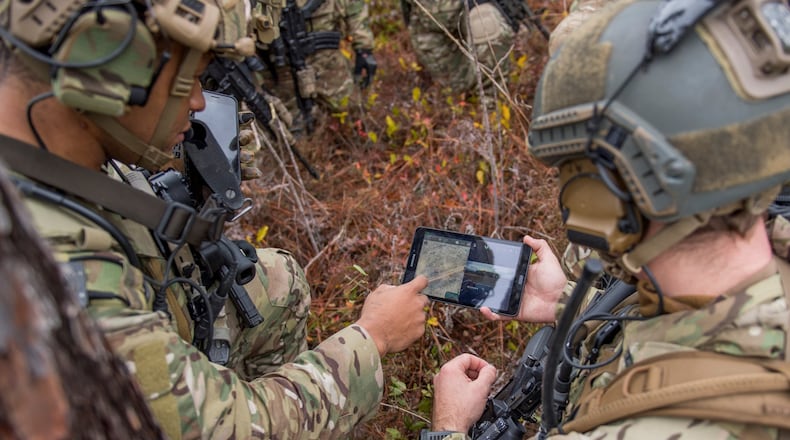“In order to develop the right capability that the operator needs at speed, we partner with Combatant Commanders every four months to ensure that what we are building addresses the array of challenges presented by the National Defense Strategy across the globe,” said Preston Dunlap, the Chief Architect of the Air Force who is kick-starting ABMS.
This initial exercise focused on defending the homeland.
“Peer competitors are rapidly advancing their capabilities, seeking to hold our homeland at risk,” said Air Force Gen. Terrence J. O’Shaughnessy, commander of U.S. Northern Command, which designed and managed this scenario.
“Working across all of the services and with industry toward solutions to complex problems ensures we meet defense challenges as well as maintain our strategic advantage in an increasingly competitive global environment,” he said.
Yet while JADC2 has been embraced for three years as a critical tool by senior leaders, including Air Force Chief of Staff Gen. David L. Goldfein, until recently it was an idea confined largely to PowerPoint slides and a slick animated demonstration of the concept.
But that changed this week when aircraft from the Air Force and Navy, a Navy destroyer, an Army air defense sensor and firing unit, a special operations unit, as well as commercial space and ground sensors came together to confront – and defeat – a simulated threat to the U.S. homeland.
Upon detection of a potential cruise missile threatening the United States, simulated by QF-16s, in quick succession using new software, communications equipment and a “mesh network,” the information was relayed to the USS Thomas Hudner, an Arleigh Burke-class destroyer deployed in the Gulf of Mexico. The same information was passed to a pair of Air Force F-35s and another pair of F-22s. Also receiving the information were commanders at Eglin AFB, a pair of Navy F-35s, an Army unit equipped with a mobile missile launcher known as HIMARS and special forces on the ground.
Events culminated on Dec. 18 when senior leaders from across the Department of Defense arrived at the test’s command and control hub for an ABMS overview and abbreviated exercise. All at once in a well-secured room, they watched real-time data pour in, and out of, the command cell. They observed information from platforms and people flowing instantly and simultaneously across air, land, sea and space that provided shared situational updates as events occurred whether the information originated from jets, or passing satellites, or from sea and ground forces on the move. Then, the group transitioned to outdoor tents to continue the exercise in a rugged environment, where senior leaders could also inspect first-hand and learn about high-speed Air Force and industry equipment and software that enabled the week’s test.
“Today’s demo is our first time demonstrating internet-of-things connectivity across the joint force,” Air Force acquisitions lead Dr. Will Roper said. “Cloud, mesh networking and software-defined systems were the stars of the show, all developed at commercial internet speeds.”
He also spoke to the necessity of industry partnership and leveraging their expertise.
“Our four-month ‘connect-a-thon’ cycle unlocks industry’s ability to iterate with testers, acquirer, and warfighters. For example, the insights from connecting the F-22 and F-35 for the first time will help our industry partners take the next leap,” Roper said.
The demonstration was the first of its kind in a series of exercises scheduled to occur roughly every four months. Each new exercise will build on the one before and include responses to problems and lessons learned.
Dunlap said the intent is to move much faster than before to conceive, build and test new technologies and strategies despite complexity or technical challenges.
“The goal is to move quickly and deliver quickly. We want to show it can be done and then we want to push ourselves to continually enhance and expand our capability in roughly four-month cycles partnering with Combatant Commanders and operators,” Dunlap said.
An equally important goal is to demonstrate the real-world value of the hard-to-describe effort in tangible, understandable ways. JADC2, previously named multi-domain operations command and control, relies on ABMS to develop software and algorithms so that artificial intelligence and machine learning can compute and connect vast amounts of data from sensors and other sources at a speed and accuracy far beyond what is currently attainable. ABMS also includes hardware updates including radios, antenna, and more robust networks that enable unimpeded data flow to operators. Aside from tools and tech, JADC2 also demands a cultural change among service men and women that embraces and responds to multi-faceted battlespaces driven by information shared across the joint force.
The critical difference going forward is to create a failsafe system that gets – and shares - real time information across multiple spaces and platforms simultaneously. Achieving this will remove barriers that can keep information from personnel and units that need it. For example, once in place, the new command and control ability will allow F-16 and F-35 pilots to see the same information at the same time in the same way along with a submarine commander, a space officer controlling satellites and an Army Special Forces unit on the ground.
About the Author
